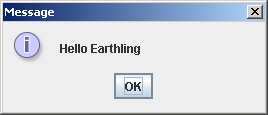Java Notes Prev: Java Example: Do Nothing | Next: Java Example: Dialog: Take me to your leader
Java Example: Dialog: Hello Earthling
This is very similar to the first program, but it actually does something. The additional parts are described below.
1 2 3 4 5 6 7 8 9 10 11 12 |
// Description: This program shows a message in a dialog box.
// File : introductory/sequential/AlienHelper.java
// Author: Fred Swartz - 2007-03-26 - Placed in public domain.
import javax.swing.*;
public class AlienHelper {
public static void main(String[] args) {
JOptionPane.showMessageDialog(null, "Hello Earthling");
JOptionPane.showMessageDialog(null, "We come in peace.");
}
}
|
- Line 5 - import
- One strength of Java is that it has many libraries or packages
of predefined classes and methods to help you do things. Some of these are automatically
known in every Java program, but you have to explicitly import others.
This
importstatement tells the compiler that you will be using part of the Graphical User Interface (GUI) library - everything injavax.swing. Typical programs have a fewimportstatements. - Lines 10-11 - Display a dialog box

This line displays this dialog box. The predefined Java class, JOptionPanecontains methods to display dialog boxes. A method is a group of Java statements for doing one particular thing. The "." following the class name is followed by the name of the method,showMessageDialog. Every method call must be followed by a parenthesized list of comma-separated arguments (often called parameters) that specify information the method needs to perform its task.The two arguments here are
null, which we'll just ignore for the moment, and"Hello Earthling", which is the message we want to display. Text messages must be enclosed in quotes. Statements are generally followed by a semicolon.
Console Output
See Java Example: Console: Hello Earthling for how this program would be written using console output.